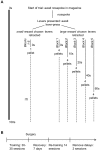Contrasting roles of basolateral amygdala and orbitofrontal cortex in impulsive choice
- PMID: 15152031
- PMCID: PMC6729470
- DOI: 10.1523/JNEUROSCI.5606-03.2004
Contrasting roles of basolateral amygdala and orbitofrontal cortex in impulsive choice
Abstract
The orbitofrontal cortex (OFC) and basolateral nucleus of the amygdala (BLA) share many reciprocal connections, and a functional interaction between these regions is important in controlling goal-directed behavior. However, their relative roles have proved hard to dissociate. Although injury to these brain regions can cause similar effects, it has been suggested that the resulting impairments arise through damage to different, yet converging, cognitive processes. Patients with OFC or amygdala lesions exhibit maladaptive decision making and aberrant social behavior often described as impulsive. Impulsive choice may be measured in both humans and rodents by evaluating intolerance to delay of reinforcement. Rats with excitotoxic lesions of the BLA and OFC were tested on such a delay-discounting procedure. Although lesions of the BLA increased choice of the small immediate reward, indicating greater impulsivity, OFC lesions had the opposite effect, increasing preference for the larger but delayed reward. The fact that the delay did not devalue the large reward to such an extent in OFC-lesioned animals supports the suggestion that the OFC is involved in updating the incentive value of outcomes in response to devaluation. In contrast, the BLA-lesioned animals markedly decreased their preference for the large reward when it was delayed, potentially because of an inability to maintain a representation of the reward in its absence. This is the first time that lesions to these two structures have produced opposite behavioral effects, indicating their distinct contributions to cognition.
Figures



Similar articles
-
Functional disconnection of the orbitofrontal cortex and basolateral amygdala impairs acquisition of a rat gambling task and disrupts animals' ability to alter decision-making behavior after reinforcer devaluation.J Neurosci. 2013 Apr 10;33(15):6434-43. doi: 10.1523/JNEUROSCI.3971-12.2013. J Neurosci. 2013. PMID: 23575841 Free PMC article.
-
Dissociable effects of lesions to orbitofrontal cortex subregions on impulsive choice in the rat.J Neurosci. 2011 Apr 27;31(17):6398-404. doi: 10.1523/JNEUROSCI.6620-10.2011. J Neurosci. 2011. PMID: 21525280 Free PMC article.
-
Lesions of the basolateral amygdala and orbitofrontal cortex differentially affect acquisition and performance of a rodent gambling task.J Neurosci. 2011 Feb 9;31(6):2197-204. doi: 10.1523/JNEUROSCI.5597-10.2011. J Neurosci. 2011. PMID: 21307256 Free PMC article.
-
Limbic corticostriatal systems and delayed reinforcement.Ann N Y Acad Sci. 2004 Jun;1021:33-50. doi: 10.1196/annals.1308.004. Ann N Y Acad Sci. 2004. PMID: 15251872 Review.
-
The contribution of orbitofrontal cortex to action selection.Ann N Y Acad Sci. 2007 Dec;1121:174-92. doi: 10.1196/annals.1401.033. Epub 2007 Sep 13. Ann N Y Acad Sci. 2007. PMID: 17872392 Review.
Cited by
-
Dissociable roles for the basolateral amygdala and orbitofrontal cortex in decision-making under risk of punishment.J Neurosci. 2015 Jan 28;35(4):1368-79. doi: 10.1523/JNEUROSCI.3586-14.2015. J Neurosci. 2015. PMID: 25632115 Free PMC article.
-
Contrasting effects of DOI and lisuride on impulsive decision-making in delay discounting task.Psychopharmacology (Berl). 2022 Nov;239(11):3551-3565. doi: 10.1007/s00213-022-06229-y. Epub 2022 Sep 15. Psychopharmacology (Berl). 2022. PMID: 36107207
-
Alcohol use dependence in fragile X syndrome.Intractable Rare Dis Res. 2016 Aug;5(3):207-13. doi: 10.5582/irdr.2016.01046. Intractable Rare Dis Res. 2016. PMID: 27672544 Free PMC article.
-
Role of nicotinic acetylcholine receptors in the effects of cocaine-paired contextual stimuli on impulsive decision making in rats.Psychopharmacology (Berl). 2012 Oct;223(3):271-9. doi: 10.1007/s00213-012-2715-z. Epub 2012 Apr 20. Psychopharmacology (Berl). 2012. PMID: 22526542 Free PMC article.
-
Contributions of medial prefrontal cortex to decision making involving risk of punishment.Neuropharmacology. 2018 Sep 1;139:205-216. doi: 10.1016/j.neuropharm.2018.07.018. Epub 2018 Jul 20. Neuropharmacology. 2018. PMID: 30009836 Free PMC article.
References
-
- Ainslie G (1975) A behavioral theory of impulsiveness and impulse control. Psychol Bull 82: 463–498. - PubMed
-
- Berendse HW, Galis-de Graaf Y, Groenewegen HJ (1992) Topographical organization and relationship with ventral striatal compartments of prefrontal corticostriatal projections in the rat. J Comp Neurol 316: 314–347. - PubMed
Publication types
MeSH terms
Grants and funding
LinkOut - more resources
Full Text Sources
